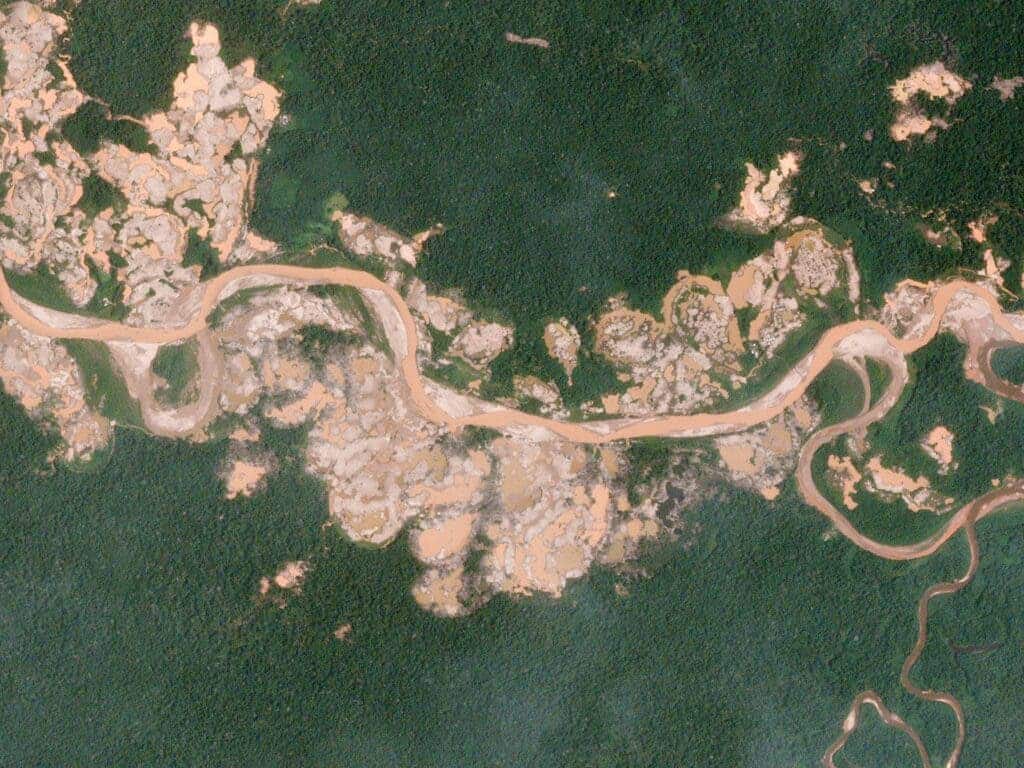Two studies challenge the long-held assumption that mercury mining is safe for local communities that are farther away. The studies in Peru found that this method of mining can pose significant threats to communities even hundreds of kilometers away.

There are several ways to mine gold, and mercury is not often one of them. However, some operations (especially small-scale gold and artisanal mining operations) still involve mercury mining.
Historically, mercury was used in placer mining. It works like this: first, the mercury is mixed with the gold ore. A mercury-gold amalgam is formed because gold will dissolve in the mercury, but other impurities will not. Then, the gold-mercury amalgam is heated to a temperature that vaporizes the mercury and leaves behind the gold — it doesn’t eliminate all impurities, but it’s pretty effective.
Mercury mining stopped in the 1960s in most places but still continues in some parts of the world. For instance, in the Peruvian Amazon.
According to two new studies, small-scale gold mining in the Peruvian Amazon poses a health hazard not only to the miners and communities near to where mercury is used to extract gold from ore, but also to downstream communities hundreds of kilometers away — especially where fish plays an important role in people’s diet.
Mercury exposure risk was highest in communities classified as indigenous, or native, regardless of proximity to mining activity. The mercury can accumulate in the fish, the two studies suggest.
The problem with mercury mining is that mercury vapor can be released into the environment, even if special equipment is used to catch the vapor. Mercury can enter the atmosphere, soil, and water if not handled with extreme care.
But tracking mercury contamination has proven very challenging, particularly in these vast and remote areas.
Taking soil or water samples also isn’t always reliable, since mercury can get taken up by animals, and tends to bioaccumulate (add up over time) in larger fish that eat lots of smaller contaminated fish.
When researchers took blood and hair samples from children in the range of these mines, they found that a third of them had mercury levels higher than the World Health Organization’s safety standards. The other children also had significant levels of mercury, though not over the ‘safe’ limit.
But here’s the thing: the correlation was weird. You’d expect children that live closer to the mines to be most exposed, but that’s not always the case.
“Assumptions about exposure are not reliable,” said co-author Caren Weinhouse, an assistant professor at Oregon Health & Science University. Many studies have looked at communities closest to the mines on the assumption that they would have the greatest mercury exposures. “If you look more closely, it turns out your first instinct may be wrong,” she said. Often communities far from mining sites had higher exposures.
Instead, mercury levels tended to be highest in communities where fish is an important part of the diet. The effects of this contamination were also concerning.
Mercury is a known neurotoxin, that can cause both muscular and mental problems. Children that had the highest levels of mercury in their blood and hair suffered a 4.68-point loss in IQ, researchers report. Even after controlling for sex, child age, maternal education, and family socioeconomic status, mercury level was correlated with overall cognitive ability, as measured on a General Cognitive Ability score.
Children with unsafe levels of mercury in their hair and blood were also found to be more anemic, lacking adequate hemoglobin to carry oxygen in their blood.
This might not be a huge decrease, but it clearly shows that there is an underlying problem — and for many kids, it could be extremely consequential over their lifetime. Furthermore, half of all children sampled were anemic.
“If you were going to have a high IQ anyway, you’ll probably still have a higher IQ after exposure, but for kids at risk for impairment, a few points can make a difference,” said Duke graduate student Aaron Reuben, who co-led the neurocognitive study on children.
Overall, the researchers say that more attention needs to be paid to mercury mining and the many health issues contamination can cause. Researchers carried measurements in 23 communities (19 rural, 4 urban) around the Amarakaeri Communal Reserve, which is bordered on the east by heavy mining activity. They measured total mercury in the hair of 2083 children and the blood of 476.
“Our paper describes some plausible biological pathways for that to happen,” said William Pan, the Elizabeth Brooks Reid and Whitelaw Reid associate professor of environmental sciences and policy at Duke. “But really, this is something we need to understand a bit more.”
Journal Reference:
- “A Population-Based Mercury Exposure Assessment Near an Artisanal and Small-Scale Gold Mining Site in the Peruvian Amazon,” Caren Weinhouse, John Gallis, Ernesto Ortiz, Axel Berky, Ana Maria Morales, Sarah Diringer, James Harringon, Paige Bullins, Laura Rogers, John Hare-Grogg, Heileen Hsu-Kim, William Pan. Journal of Exposure Science & Environmental Epidemiology, May 28, 2020. 10.1038/s41370-020-0234-2
- “Elevated Hair Mercury Levels Are Associated with Neurodevelopmental Deficits in Children Living Near Artisanal and Small-Scale Gold Mining in Peru,” Aaron Reuben, Helena Frischtak, Axel Berky, Ernesto Ortiz, Ana Maria Morales, Heileen Hsu-Kim, Laura Pendergast, William Pan. GeoHealth, May 20 2020. doi.org/10.1029/2019GH000222






